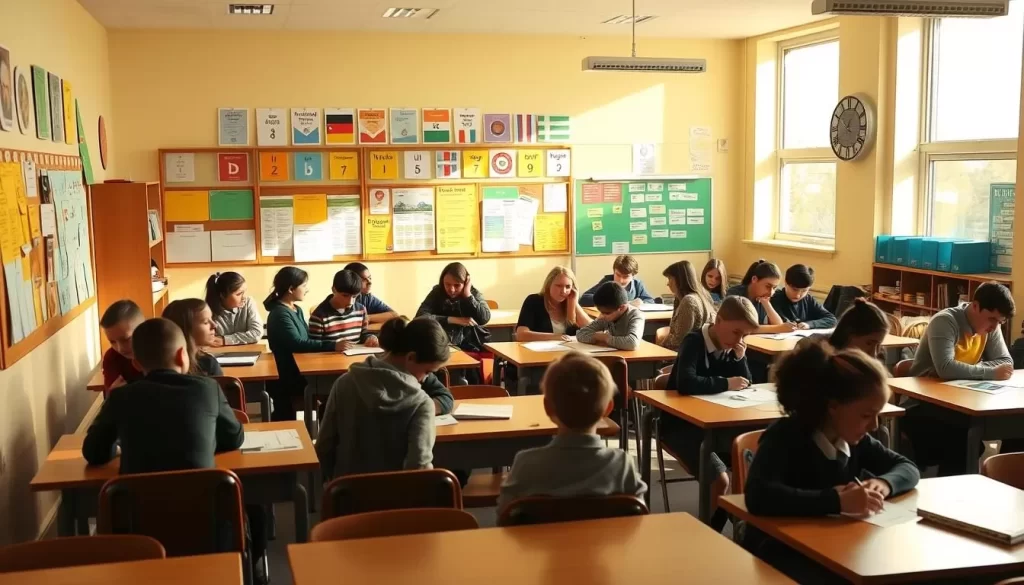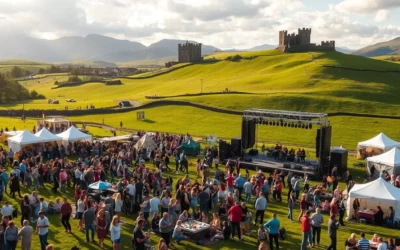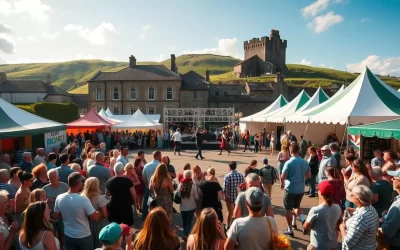✓ Accommodations ✓ Flights ✓ Rental Cars
When you think about the language landscape of this region, English is the most commonly used. It’s spoken by nearly everyone, making it the de facto choice for daily communication. However, the culture and identity of the area are deeply tied to other languages as well.
In 2022, Irish gained official language status, marking a significant milestone. This move reflects the growing recognition of its importance in the community. Ulster Scots, another key language, holds minority status and is cherished by many.
The region’s linguistic heritage is rich, shaped by centuries of history. From early Celtic roots to post-Norman influences, each era has left its mark. Today, this variety of languages adds to the unique character of the area.
This article will guide you through the historical evolution, current policies, and cultural significance of these languages. Whether you’re a student or simply curious, you’ll find valuable insights here.
Overview of Northern Ireland’s Linguistic Heritage
The linguistic heritage of this region is a tapestry woven through centuries. From ancient roots to modern practices, the language landscape reflects a rich history. Let’s dive into the key influences that shaped this unique culture.

Ancient Roots and Historical Influences
The earliest records trace back to Primitive Irish in the 5th century. This was the foundation of the language spoken by Celtic tribes. Latin also played a significant role, especially in religious and official contexts after the Norman conquest.
Over time, Norman and British influences reshaped the development of local dialects. These shifts created a variety of linguistic practices that still echo today.
The Evolution of Language Across the Centuries
By the 17th century, the Administration of Justice (Language) Act marked a turning point. It reinforced English as the dominant language in legal and official settings. This policy had a lasting impact on the community.
Despite these changes, Gaelic heritage remains evident in place names and traditions. The evolution from early dialects to modern forms like Ulster Irish and Ulster Scots highlights the resilience of this culture.
Today, the region’s linguistic practices are a blend of ancient traditions and contemporary influences. This identity continues to shape the lives of its people.
Northern Ireland, United Kingdom: Official and widely spoken languages
The region’s linguistic landscape is shaped by a mix of history and modern influences. From everyday conversations to formal settings, language plays a central role in defining its identity. Let’s explore the key languages that shape this unique culture.

English: The De Facto National Language
English is the most widely spoken language in the region. It’s used in schools, workplaces, and daily interactions. Variations like Ulster English and Hiberno-English add local flavor to the way people communicate.
For example, Ulster English includes distinct pronunciations and phrases. These differences reflect the region’s rich history and community ties. Whether you’re a student or a visitor, understanding these nuances can deepen your connection to the area.
Irish and Ulster Scots: Embracing Cultural Identity
Irish gained official language status in 2022, marking a milestone for its speakers. This recognition highlights its importance in preserving the region’s heritage. Ulster Irish, a local variant, is taught in schools and celebrated in cultural events.
Ulster Scots, another key language, is cherished by many. It reflects the area’s unique identity and is supported by public initiatives. Together, these languages enrich the culture and strengthen the community.
Efforts like bilingual programs and festivals ensure these languages thrive. Organizations like Foras na Gaeilge play a vital role in promoting their use. These initiatives show how language can bridge the past and present.
Diverse Linguistic Influences and Minority Languages
From sign languages to immigrant dialects, the region’s linguistic identity is a blend of tradition and modernity. This diversity reflects the culture and community ties that have shaped the area over time. Let’s explore how these influences contribute to the unique linguistic landscape.

Sign Languages and Their Cultural Significance
Sign languages play a vital role in the community, offering a unique way to connect. Northern Ireland Sign Language (NISL) and Irish Sign Language (ISL) gained official recognition in March 2004. This milestone highlights their importance in fostering inclusivity.
NISL and ISL are used differently across communities. While NISL is more prevalent in urban areas, ISL is often favored in rural settings. Both languages are taught in schools and supported by public initiatives, ensuring their continued development.
Immigrant Languages Shaping Modern Community Identity
Immigrant languages have enriched the linguistic mosaic of the region. According to the 2011 census, Polish, Lithuanian, and Romanian are among the most spoken. These languages bring new vocabulary and perspectives, reflecting the area’s evolving identity.
For example, Polish is now widely used in public services and local media. This inclusivity helps immigrant communities feel more connected. Lithuanian and Romanian speakers also contribute to the region’s cultural diversity.
| Language | Number of Speakers (2011 Census) |
|---|---|
| Polish | 18,384 |
| Lithuanian | 7,805 |
| Romanian | 1,567 |
Government policies and community initiatives support these languages. Programs like bilingual education and cultural festivals ensure they thrive. For more insights into the linguistic landscape, visit this resource.
These diverse influences highlight the region’s commitment to preserving its linguistic heritage while embracing modern changes. Whether you’re a student or a visitor, understanding these languages can deepen your connection to the area.
Linguistic Policy, Education, and Community Engagement
Language plays a pivotal role in shaping the identity and culture of any community. In this region, efforts to preserve and promote linguistic diversity are evident through education, public services, and legislative support. These initiatives ensure that both traditional and modern languages thrive.

Language Initiatives in Education and Public Services
Schools and universities are at the forefront of language preservation. Courses in Irish and Ulster Scots are offered to students, fostering a deeper connection to their heritage. Bilingual signage and translations in public spaces further emphasize the importance of these languages.
For example, street names and government communications often appear in both Irish and English. This approach not only supports language development but also strengthens community ties. Programs like the Primary Modern Languages Programme have also introduced foreign languages, enriching the educational experience.
Legislation and Community Support for Language Development
Legislative measures, such as the Good Friday Agreement, have been instrumental in promoting linguistic diversity. These policies ensure that languages like Irish and Ulster Scots receive the recognition and support they deserve. Community organizations, such as Foras na Gaeilge, play a vital role in this process.
Recent changes, like the official recognition of Irish, highlight the ongoing commitment to language preservation. Public initiatives and festivals further engage the community, making language learning accessible and enjoyable. For more insights, explore the language education policy.
Together, these efforts create a collaborative environment where linguistic heritage is celebrated and preserved for future generations.
Conclusion
The linguistic tapestry of this area reflects a blend of history and modern influences. Language has always been a cornerstone of its identity, from the dominance of English to the revival of Irish and the preservation of Ulster Scots. These languages are not just tools for communication but symbols of a rich culture.
Legislative and educational efforts ensure these languages thrive. Public initiatives and community programs play a vital role in preserving this heritage. Minority languages and immigrant influences further enrich the linguistic landscape, making it a vibrant part of the region’s community.
Understanding this linguistic diversity offers a deeper connection to the area’s past and present. For more insights into the UK’s linguistic heritage, explore this resource. The evolution of language here is ongoing, shaping education, public services, and cultural celebrations.
Preserving this heritage is essential for future generations. It ensures the region’s unique identity remains vibrant and alive.
The above is subject to change.
Check back often to TRAVEL.COM for the latest travel tips and deals.






